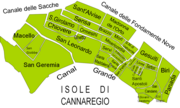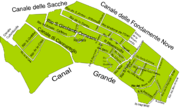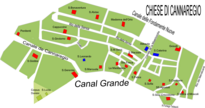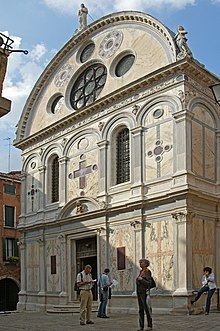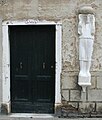Cannaregio
Cannaregio is the most densely populated district ( sestiere of Venice ) in Venice . The 13,169 inhabitants (as of December 12, 2007) of the sestiere are divided between the parishes of San Giobbe e Bernardino (with Opera Pia Contarini), San Marcuola (with Santa Fosca), Madonna dell'Orto (with San Marziale, Ospedale Fatebenefratelli and Casa Card . Piazza), Sant'Alvise (with San Bonaventura (Carmelitane) and Canossiane), San Girolamo (with Santa Maria Madre del Redentore and Ist. Suore Dorotee), San Felice (with Santa Sofia), Santi Apostoli (with Gesuiti) and San Canciano (with San Giovanni Crisostomo and Santa Maria dei Miracoli). The area covers 150 hectares.
Cannaregio is located in the northwest of Venice and is only surpassed by Castello in terms of area. The name is supposedly derived from the state of the sestiere, which it had before the settlement, when it was a boggy area in which reeds ( canna in Italian : reeds) grew.
structure
The Canal Grande , called "Canalazzo" by the Venetians, begins in Cannaregio and winds in the shape of an inverted "S" to San Marco . Originally, the opening of the Grand Canal facing the mainland was not the main entry route. This function was fulfilled by the Cannaregio Canal, which flows into the Grand Canal after the Ponte delle Guglie at Palazzo Labia .
Most workers and employees live in Cannaregio, and many small businesses are located there. The artery of the district is the route of the Strada Nova, which stretches from the Ponte delle Guglie, initially Rio terrà San Leonardo, then Rio terrà della Maddalena and briefly named Via V. Emanule, to Campo SS. Apostoli. From Strada Nova towards the train station, only interrupted by Campo San Geremia, you come to the Rio terrà Lista di Spagna. In this street there are white marble strips embedded in the pavement along the house facades. Behind this strip was extra-territorial area, as many foreign embassies were housed here. The term “Rio terrà” is derived from the fact that these streets were originally canals that were filled in ( interrare : to fill up) and thus created passable paths.
bridges
Several important bridges can be found in Cannaregio. The Ponte degli Scalzi spans the Grand Canal near the station, the Cannaregio Canal is crossed by the Ponte delle Guglie and the Ponte di Tre Archi (Andrea Tirali). The fourth bridge over the Grand Canal was completed in 2008 with the Ponte della Costituzione . It connects Cannaregio with Santa Croce from the Fondamenta S. Lucia area to Piazzale Roma.
Churches
Important churches are the Chiesa Santa Maria di Nazareth, also called Chiesa degli Scalzi, San Geremia , San Giobbe, Madonne dell'Orto, La Maddalena, Santa Maria della Misericordia, Santi Apostoli, Chiesa dei Gesuiti, San Giovanni Crisostomo and Santa Maria dei Miracoli .
The church of Santa Lucia had to give way to the construction of the train station in the 19th century and was demolished. The Chiesa degli Scalzi (Church of the Barefooted) was bombed in World War I, which caused a vault with a fresco by Tiepolo to collapse. In 1813, Sebastian von Heinzelmann donated a building from 1713 as the Chiesa Evangelica Alemanna . Members of the Nazione Alemanna , approved German merchants, secretly founded the associated Evangelical Congregation of Augsburg Confession in the 17th century, which is why they had their place of worship in rooms 81 and 82 of the Fondaco dei Tedeschi in the neighboring sestiere San Marco until the evacuation by Napoleon in 1806 .
In Cannaregio we also find the Ghetto nuovo with three Ashkenazi synagogues and the Museo Ebraico . A bridge leads to the Ghetto Vecchio, which extends in the direction of the Cannaregio Canal and houses two Sephardic synagogues. Due to the restrictive regulations in the Middle Ages, according to which Jews were only allowed to settle in the ghetti, one was forced to make the best possible use of the little land that could be built on and therefore built higher up. Nowhere else in Venice can you find five- to six-story apartment buildings.
Not to be forgotten is the island of San Michele , which also belongs to Cannaregio . Originally made up of two islands (San Michele and San Cristoforo), they were united to serve as the municipal Catholic cemetery. Before this union and rededication, San Michele was inhabited by monks who maintained a large library. The Lutheran cemetery, which has existed on San Cristoforo since 1719, was unceremoniously destroyed when the islands were connected by filling on behalf of the city administration without the consent of the community. The first church in Venice to be built in the Renaissance style was designed by the architect Mauro Codussi .
The sestiere had twelve contraden (parishes) in 1171, as did Castello and Cannaregio. In 1586 the number had risen to 13.

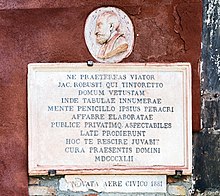
Secular buildings
One of the most magnificent palazzi is the Ca 'd'Oro . The name is derived from the facade that was once covered with gold leaf. The palazzo is built in the Gothic style and has changed hands many times over the centuries, which have often not been handled with great care. Today it belongs to the city of Venice and is set up as a museum.
Other important palazzi are the Palazzo Labia on Campo S. Geremia, which is used by the Italian radio (RAI) as an office and broadcasting station. The Palazzo Vendramin Calergi, in which Richard Wagner's room is located, is now home to the city's casino.
The Ca da Mosto ' , situated just after the mouth of the Rio dei Santi Apostoli in the Grand Canal, is the birthplace of the famous navigator Alvise da Mosto and one of the oldest palazzos of Venice. A splendid example of Gothic architecture is the Palazzo Soranzo van Axel, which is not far from the church of Santa Maria dei Miracoli.
Not to be forgotten is the Corte seconda del Milion, where Marco Polo's house was destroyed by fire . The Palazzo Mastelli is located on the Rio Madonna dell'Orto, a little away from the tourist crowds. Its façade is decorated with camel figures that indicate the former owners' trade relations with the Orient. Shortly before that, on Campo dei Mori , is the house where Jacopo Robusti was born, the son of a wool dyer who went down in art history as Tintoretto ( tingere : to dye, tinto = dyed). The Campo dei Mori is one of the low-lying areas of the city and regularly flooded during "acqua alta".
The Verrocchio foundry, where the statue of Bartolomeo Colleoni was made, was located near the Madonna dell'Orto church . A “squero”, a gondola shipyard, was also in operation in Cannaregio until the second half of the 20th century, but it has ceased operations. The last remaining "squero" is in Dorsoduro , near San Trovaso.
- Campo dei Mori
See also
Individual evidence
- ^ Venice (Touring club italiano) on books.google.de
- ↑ Alberto Bolognetti, papal nuncio in Venice from 1578 to 1581, complained about the mischief of German Lutherans, but formally they probably did not form a community until 1646. Cf. Stefan Oswald, The German Protestant Community in the Republic of Venice , Venice: typescript, o. J., pp. 2 and 4.
- ^ Stefan Oswald, The German Protestant Congregation in the Republic of Venice , Venice: Typescript, n.d., p. 4.
- ^ Stefan Oswald, The German Protestant Congregation in the Republic of Venice , Venice: Typescript, n.d., pp. 11 and 13.
Coordinates: 45 ° 27 ' N , 12 ° 20' E



